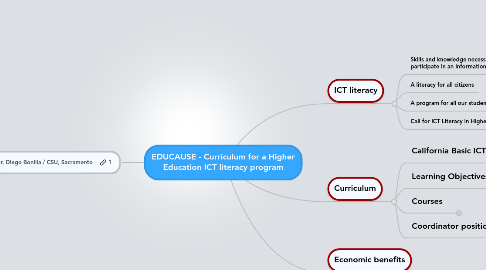
1. Dr. Diego Bonilla / CSU, Sacramento
2. ICT literacy
2.1. Skills and knowledge necessary to fully participate in an information driven society
2.2. A literacy for all citizens
2.3. A program for all our students
2.4. Call for ICT Literacy in Higher Education
2.4.1. OECD
2.4.1.1. The Seoul Declaration for the Future of the Internet Economy
2.4.2. US
2.4.2.1. AACU's College Learning for the New Global Century
2.4.3. California
2.4.3.1. Governor’s Digital Literacy / ICT executive order
2.4.3.2. 2010 Digital Literacy Pathways in California Report
3. Curriculum
3.1. California Basic ICT Literacy Elements
3.1.1. Summarizing Table
3.1.1.1. Access information
3.1.1.2. Manage information
3.1.1.3. Integrate information
3.1.1.4. Evaluate information
3.1.1.5. Create information
3.1.1.6. Communicate
3.1.1.7. Global Understanding
3.1.1.8. Personal qualities
3.1.2. Organizations establishing standards and performance indicators
3.1.2.1. International Society for Technology in Education and Training (ISTE)
3.1.2.2. Educational Testing Services (ETS) - ICT Literacy
3.1.2.3. Certiport – ICT Digital Literacy Assessment
3.1.2.4. Partnership for 21st Century Skills
3.2. Learning Objectives
3.2.1. Skills
3.2.1.1. ICT Literacy
3.2.1.1.1. Exercise control over personal information and privacy in online environments
3.2.1.1.2. Conduct information searches critically and effectively in public and proprietary databases, and to manage digital information for analysis and synthesis
3.2.1.2. Digital Media Literacy
3.2.1.2.1. Create all forms of digital media assets including images, vectors, audio, video, and 3D models at a basic level
3.2.1.2.2. Publish all forms of digital media on the Internet
3.2.1.3. Communicate synthesized information effectively with online multimedia presentations
3.2.2. Knowledge
3.2.2.1. Know Copyright Law, Fair use, and Creative Commons licenses as to be able to participate legally in an information driven society.
3.2.2.2. Comprehend the impact of online communication in several levels of human communication (for example, interpersonal communication, group communication, and organizational communication).
3.2.2.3. Comprehend the historical development of media, its convergence towards a digital form, and the impact of the transcoding of traditional mass media into a programmable format.
3.2.3. Values
3.2.3.1. Explain the role of ICT literacy and Digital Media literacy to succesfully participate in a global information and knowledge-based economy.
3.2.3.2. Explain the importance of understanding human, cultural, and societal issues regarding the adoption of Information and Communication Technologies as to participate in an information driven society.
3.3. Courses
3.3.1. Skills
3.3.1.1. ComS101 - Information Management and Privacy
3.3.1.1.1. Catalog Description
3.3.1.1.2. Areas of Knowledge
3.3.1.1.3. Core Assessment
3.3.1.2. ComS106 - Digital Media Creation - An Introduction
3.3.1.2.1. Catalog Description
3.3.1.2.2. Skills and Knowledge
3.3.1.2.3. Core Assessment
3.3.1.3. ComS117 - Multimedia Communication
3.3.1.3.1. Catalog Description
3.3.1.3.2. Areas of Knowledge
3.3.1.3.3. Core Assessment
3.3.2. Skills and theory
3.3.2.1. ComS140 - Online Collaboration
3.3.2.1.1. Catalog Description
3.3.2.1.2. Areas of Knowledge
3.3.2.1.3. Case Studies
3.3.3. Theory
3.3.3.1. ComS190 - Human Communication on the Internet
3.3.3.1.1. Catalog Description
3.3.3.1.2. Areas of Knowledge
3.3.3.1.3. Core Assessment
3.3.3.2. ComS191 - New Media and Society
3.3.3.2.1. Catalog Description
3.3.3.2.2. Areas of Knowledge
3.3.3.2.3. Core Assessment
3.4. Coordinator position
3.4.1. As information and communication technology changes, these courses require ongoing updates. The coordinator works with involved faculty to avoid content overlap and to maintain currency.
